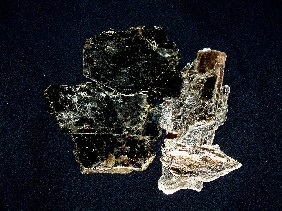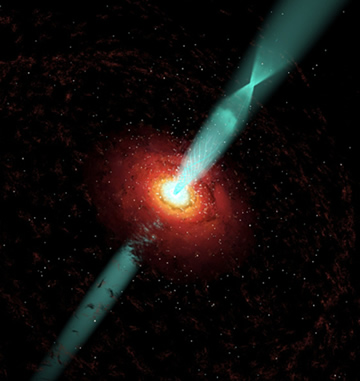This picture, created by an artist, shows the area near a supermassive black hole where jet of particles flow in spirals. Research suggests this pattern is due to twisted magnetic fields.
Click on image for full size
Image courtesy of Marscher et al., Wolfgang Steffen, Cosmovision, NRAO/AUI/NSF
Catching a Glimpse of a Black Hole's Fury
News story originally written on April 23, 2008
Using the National Science Foundation's (NSF) Very Long Baseline Array (VLBA) and a host of international telescope partners, a team of researchers has made the clearest observation yet of innermost region of a black hole.
From the observations, astronomers found strong evidence that the enormous jets of particles emitted by supermassive black holes are corkscrewed in a way predicted by theory. The researchers believe the coiling is a result of twisted magnetic fields acting on the particle streams.
The researchers reported their findings in the April 24 issue of Nature.
Led by Alan Marscher of Boston University, the international team of researchers studied the galaxy BL Lacertae located 950 million light years from Earth. By observing an outburst from the galaxy from late 2005 to 2006, the team observed bursts of photons oriented in a way predicted by theories about the twisted magnetic fields of black holes.
The VLBA is part of NSF's National Radio Astronomy Observatory (NRAO). A more detailed release--including graphics and a broadcast-quality animation--is available from NRAO at: http://www.nrao.edu/pr/2008/bllac
Additional images, explanations, data sets and even a related song are available at a Web site posted by Marscher: http://www.bu.edu/blazars/BLLac.html
Last modified May 8, 2008 by Lisa Gardiner.
You might also be interested in:

The introduction of telescopes to the study of astronomy opened up the universe, but it took some time for astronomers to realize how vast the universe could be. Telescopes revealed that our night sky
...more
A new study has found that a mixing of two different types of magma is the key to the historic eruptions of Mount Hood, Oregon's tallest mountain, and that eruptions often happen in a relatively short
...more
Researchers have found a primitive Earth mantle reservoir on Baffin Island in the Canadian Arctic. Geologist Matthew Jackson and his colleagues from a multi-institution collaboration report the finding--the
...more
Some geologic faults that appear strong and stable, slip and slide like weak faults. Now an international team of researchers has laboratory evidence showing why some faults that 'should not' slip are
...more
A new analysis of the unusually long solar cycle that ended in 2008 suggests that one reason for the long cycle could be a stretching of the sun's conveyor belt, a current of plasma that circulates between
...more
Anyone who has ever cut down a tree is familiar with the rings radiating out from the center of a tree trunk marking the tree's age. Careful study of tree rings can offer much more: a rich record of history
...more
Earth's first life form may have developed between the layers of a chunk of mica sitting like a multilayered sandwich in primordial waters, according to a new hypothesis. The mica hypothesis, which was
...more















